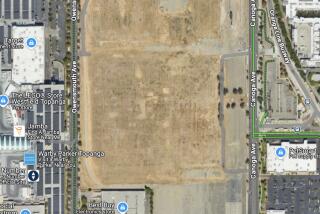Toxics Still Plague El Toro Air Base : Hazardous waste: Military station is included with Camp Pendleton and Edwards Air Force Base on Defense Department’s priority list for cleanup.
- Share via
WASHINGTON — The El Toro Marine Corps Air Station, contaminated by radioactive waste and other hazardous materials, will remain one of the 94 national environmental priority sites under a Department of Defense cleanup program, according to a report released Friday.
For the first time, Camp Pendleton Marine Corps Base in San Diego County has been proposed for the cleanup list because of ground-water and soil contamination from PCBs, pesticides, solvents and fuels.
Edwards Air Force Base, contaminated by nitric acid, solvents and other volatile substances, also has been nominated for the priority list.
The three bases were featured in the fourth annual “Defense Environmental Restoration Program” report to Congress, which describes the military’s progress in removing contamination and controlling the generation of hazardous wastes. Under a 1984 law, cleanup of sites in the program is handled through an inter-agency agreement between the Defense Department and the U.S. Environmental Protection Agency.
Cleanup at El Toro was given a heightened urgency last week when the base was placed on the EPA’s Superfund list of toxic sites. Federal officials have cited low levels of radioactive waste, explosives and scattered deposits of battery acid and fuels in abandoned storage drums. Several landfills and firefighter training pits may contain jet fuel and paint thinners. Also, ground water was polluted by four decades of military dumping, EPA officials have said.
Overall, 14,401 sites at 1,579 Army, Navy, Air Force and Marine bases nationwide were included in the 1989 fiscal year report. California had 1,713 sites at 112 bases, the highest figures for any state.
The military spent $467.8 million last year to investigate and clean up these contamination problems. Another $35.2 million went to reducing the generation of hazardous waste.
The DOD progress report touted site inspections at 13,941 sites and said cleanup work had been completed at 287 locations and was under way at another 965.
At Edwards, the Air Force’s preeminent flight-test center located outside Lancaster in northern Los Angeles County, 26 sites have been identified as drum disposal areas, waste disposal pits, underground storage tanks, a leaking jet fuel pipeline, landfills, fire protection training areas and spill locations, the DOD report said.
The problem areas are on the main/south base, which is used primarily for maintaining and refueling aircraft.
“Large amounts of fuel have been spilled and poor disposal practices have resulted in the release of organic solvents to the ground there,” the report said.
“Other sites in the area include an abandoned sanitary landfill containing pesticides and heavy metals, an area where electroplating wastes were dumped, and the industrial waste pond, which contains heavy metals concentrations.”
Various toxic substances, including trichloroethylene--a chemical widely used in aerospace that is a suspected human carcinogen under conditions of chronic exposure--are present in shallower ground-water aquifer underlying the base, the report said. The base’s 13,800 employees get drinking water from wells within three miles of main base.
In 1989, a ground-water treatment system was installed and 15 underground storage tanks were removed, the report added. Drums, contaminated soil, tanks and other contaminants were previously removed and ground water will continue to be monitored. In recent years, $11.1 million has been spent to document and clean up the problems, DOD reported.
“We’re already involved in that kind of cleanup program now and we have been for several years,” said Edwards spokesman Dennis Shoffner. “Our attitude here is to comply with the law, not to balk at it.”
More to Read
Sign up for Essential California
The most important California stories and recommendations in your inbox every morning.
You may occasionally receive promotional content from the Los Angeles Times.










